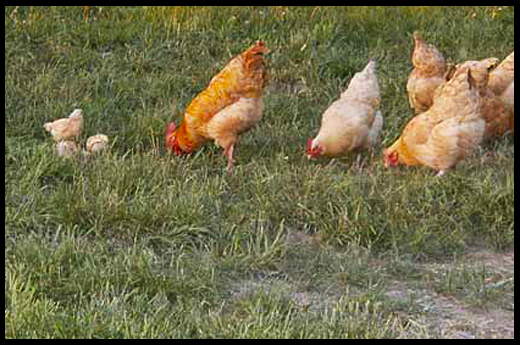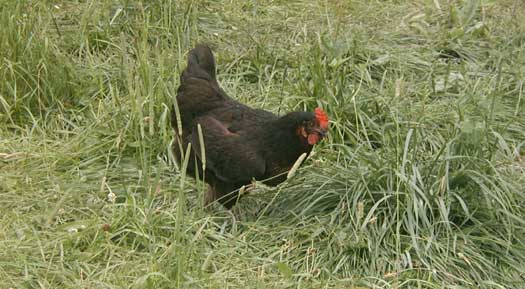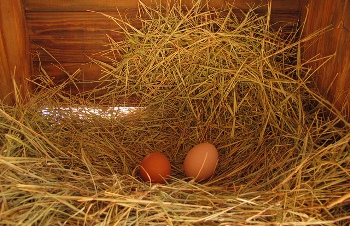by guest blogger Jean Nick, author and sustainability expert
When I was perhaps 10 years old, a lone Rhode Island Red hen wandered out of the woods and into the yard. We figured, given that she was a long way from anywhere, she must have fallen off a passing truck. My mother never turned away a needy animal, so Henny Penny joined the menagerie, spending her nights snug in an old rabbit hutch given to us by a neighbor.
Come spring, her mind turned—as hen’s minds are wont to do—to motherhood and she went broody, sitting glassy-eyed and inert on her nest eggs (which were in fact, milk-glass eggs my mother unearthed and tucked in so Henny Penny wouldn’t notice we were taking her egg each day and hide a nest somewhere else). Lacking a rooster on the place, she wasn’t going to get anywhere even sitting on her own eggs, so after a few weeks my mother couldn’t stand such hopeful and doomed devotion any longer. She had my Dad stop at a local hatchery and bring home a pair of lovely fluffy New Hampshire Red hen chicks, which she tucked under Henny Penny that night—much to the delight of everyone involved the next morning. And that was the start of my first brood of chickens.
Having a few hens is a great way to make good use of kitchen and garden leftovers, harvest your very own amazing-tasting eggs, cut your food miles, and get the greatest compost bin on the block (chicken poop is wonderful stuff). Chickens are also great fun to watch: Each one has a slightly different personality, and they get quite fond of the hand that feeds them. If you have even a small yard, you have room for a few good hens (just be sure to check, anonymously, with your municipal office to be sure they are legal and go from there).
Q: So, how many hens DO I need?
A: At the bottom end, you need at least two, as they are social creatures and keeping just one is cruel (unless you put her in a diaper and make her into a house pet, which, yes, you can do). After 24 to 32 weeks of growing up, your hens will lay an egg almost every day for eight or nine months straight, then take a break for a few weeks to a few months (typically in the winter), and then start laying again. Each time they start laying again, they will lay fewer, but larger, eggs.
It is not unusual for a pet hen to lay for five years—at which point she may be laying only a couple of eggs a week on average—and to live even longer. Think about how many dozen eggs you and your family typically use in a week and figure on starting with two standard-size (or four bantam-size) hen chicks per dozen. Then plan on adding about half that many every spring to keep egg production up (assuming you will be keeping your old girls on for their natural lives and not inviting them to dinner when production starts to dwindle).
Q: Where do I get chickens and what kind of chickens should I get?
A: Short of having a hen stroll into your yard uninvited, there are two ways to acquire a few hens: as baby chicks or adult birds. Baby chicks have the advantage of turning up at local feed stores in the spring in many areas or being able to be shipped through the mail (a chick doesn’t need to eat for 48 hours after hatching as it finishes absorbing the last of the yolk that sustained its development inside the shell). The downside is they need more care than adults for the first couple of months and you could potentially end up with male chicks because chick sexers at hatcheries make a mistake 2 or 3 percent of the time. You won’t find out for a couple of months, and then what are you going to do?
Unless you are OK with “doing in” a young cockerel and inviting him to dinner, I’d suggest selecting a “sex-link” hybrid breed; with these the boy and girl chicks are clearly different colors, making it next to impossible to pick out a boy when you wanted a girl. Brown sex-link chicks are commonly available (you want the reddish-gold ones, not the yellow ones) and grow into happy brown hens that lay lots and lots of big brown eggs. Black sex-link chicks are also be available; with those, you want the solid black chicks, not the ones with a white or gray star on the top of their heads. Buying chicks at a local store in the spring allows you to buy just a couple. In PA we have to buy at least six at a time, but I don’t think most states have that restriction.
You could also ask the egg-sellers at your local farmers market if they plan to retire any hens soon and arrange to adopt a few. Chances are such hens will be 2 or 3 years old and laying three or four eggs a week, so you’ll want to get a few more than if you bought chicks. Also, they may rest for a few weeks when you first get them home, but they will start up again soon—much sooner than chicks will take to start laying—and they will soon grow smooth, glossy feathers to replace their somewhat moth-eaten plumage and will get friendlier as they get used to you.
If you (and your neighbors) don’t mind the possibility of an avian alarm clock with his own morning schedule sneaking into your mini-flock, you can start with chicks from dozens of breeds. Some of my favorites are Buff Orpingtons, Rhode Island Reds, Delawares, and White Rocks (big white hens that somewhat confusingly lay big brown eggs). Mail-order hatcheries offer dozens of breeds, many of them pre-sexed (just remember that sexing isn’t 100 percent accurate) rather than “straight run” (unsexed and at least 50 percent male…and sometimes far more, in my experience). Other than getting males (and maybe having to have one or two to dinner before they start sounding off), the downside of straight run selection is that most sellers require you to buy as many as 25 chicks at a time so they can keep each other warm in transit. That’s way too many for a single family. Of course, going in with a few like-minded friends will solve this. One exception is My Pet Chicken, which will ship far fewer at a time (the exact number is based on your zip code) and also ships ready-to-lay hens (for would-be hen-owners with deep pockets). They also offer a guide for figuring out which breeds may be a good match for you.
Buying fertile eggs and hatching them is fun but more trouble, and you will almost certainly get at least half roosters. If what you want is a few hens, I’d stick to buying chicks or adult hens.
Q: How do I take care of my chicks for the first month or so?
A: While you can buy all sorts of chick gear, all you need for a few chicks is a desk lamp with a standard incandescent bulb, a large cardboard box, and a big bag/bale of wood shavings (NOT cedar, which is toxic to birds) for their home, along with a bag of chick starter mash (organic, if you can find it) and two heavy saucers for their cafeteria. If it is below freezing outdoors, you will need to keep the box in a heated area for at least a few weeks—a garage or closed in porch is good as long as the temperature doesn’t get below 50 or so, and will keep the fine dust the babies create out of your house.
Put an inch or so of shavings in the box and set the light up in one corner of it. The space under the light should be about 95°F; adjust the height of the lamp or the strength of the bulb as needed. The light will stay on 24/7 and the chicks will move under it when they are cold. Put the two saucers in the other corner. Fill one saucer with about ½ inch of water and the other with a few tablespoons of food. Now add your chicks. Dump, wash, and refill the food and water a couple of times a day, and add handfuls of dry shavings to cover any wet or soiled areas. (Use common sense about washing your hands and the dishes the chicks have soiled away from areas where you prepare human food, as they, like any animal, can sometimes have germs that could make you ill.)
After the first few days, you’ll need to start increasing the amount of food you give so the chicks just about, but not quite, finish it all up by the next time you clean the dishes. Switch to a larger water bowl as needed so that they always have water to drink. You can also offer them bits of greens to add variety and vitamins, and start giving them the idea to forage. After three weeks or so, your girls will start hopping and flying, but you can keep them in a big box until about six weeks by covering it with a screen or piece of wire mesh. They may also no longer need the light if the box is in a warm place; you can turn it off during the day once they never seem to be under it, and even leave it off completely as they start getting feathers.
After four to six weeks, you’ll want to have a safe and cozy home prepared for them outside. I’ll tell you more on that the next time I’m visiting here in Maria’s kitchen. (Warning: backyard hens can be addictive!)
 Jean Nick, has been writing about gardening and sustainable living for decades. She has worked at Rodale since 1991, and started reading Organic Gardening magazine in 1972. In her spare time, she gardens, helps manage a sustainable farm, listens to audio books, makes all manner of useful and tasty things, and comments on eco-logical and eco-nomical topics as Rodale.com‘s Nickel Pincher.
Jean Nick, has been writing about gardening and sustainable living for decades. She has worked at Rodale since 1991, and started reading Organic Gardening magazine in 1972. In her spare time, she gardens, helps manage a sustainable farm, listens to audio books, makes all manner of useful and tasty things, and comments on eco-logical and eco-nomical topics as Rodale.com‘s Nickel Pincher.







We have 12 female chicks who are now 4 weeks old, 6 Isa Browns and 6 Australorps (black). They all have definite personalities and are fun to watch. Very addictive.
I always try to keep chickens and have never experienced the problem that occured lately. I had a rooster with my few hens then someone gave me four more hens. Two hens were the same breed and looked exactly alike. The rooster continually attacked only one of the hens. He would attack from the front pulling all her feathers and comb off and opening her head. I would confine him for weeks in an area where he was exposed to all the hens thinking he would acclamate himself to her and leave her alone. Then as soon as I let him loose, he would head for her and repeat the whole process again. Do you have any explanation for this behavior? I would appreciate advice.
Thanks, Nita
I agree. Chickens ARE fun to watch! We had a “tractor” outside our living room window one year and their personalities are so fascinating to watch. We call it “chicken TV.”
Nita,
In my experience hens fight hens and roosters fight roosters, but roosters don’t tend to fight hens. Roosters are often particularly attentive to certain hens, so some hens may end up with bare backs and bare patches/torn combs from the roo mounting and hanging on. Occasionally a hen objects to being mounted at all and tries to get away after the roo grabs at her head, which might explain your case. And once a bird shows blood all the others will peck at it, which might also be contributing. Another possibility is that the hen in question isn’t actually a hen, but a rooster with poorly developed sexual characteristics (if you’ve never seen her lay an egg, you might try segregating her; if “she” doesn’t lay after a month or so you may well have a she-he, and the answer to your question). Right now segregating her sounds like the kindest and most effective option regardless.